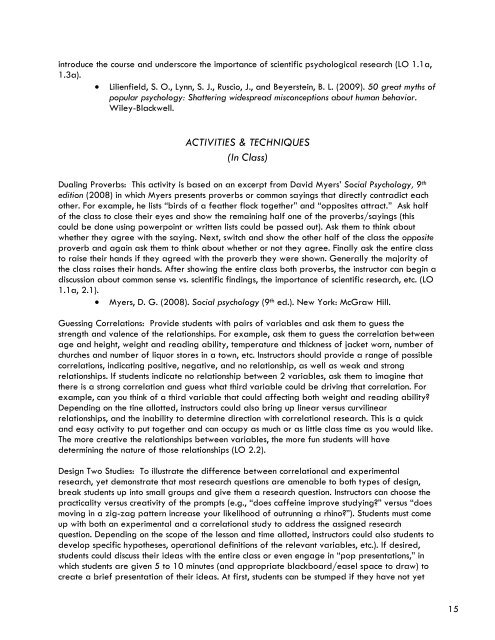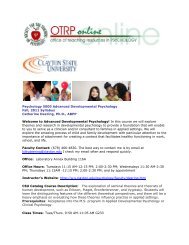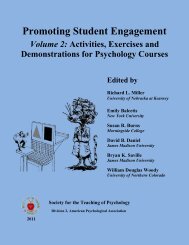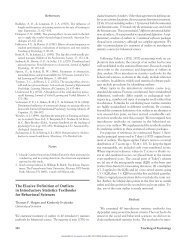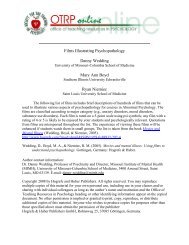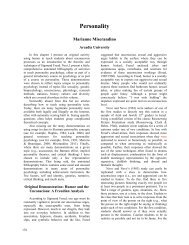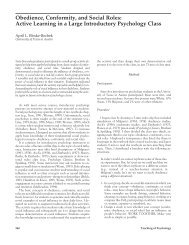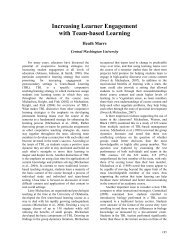INTRODUCTORY PSYCHOLOGY TEACHING PRIMER Early Career ...
INTRODUCTORY PSYCHOLOGY TEACHING PRIMER Early Career ...
INTRODUCTORY PSYCHOLOGY TEACHING PRIMER Early Career ...
Create successful ePaper yourself
Turn your PDF publications into a flip-book with our unique Google optimized e-Paper software.
introduce the course and underscore the importance of scientific psychological research (LO 1.1a,<br />
1.3a).<br />
• Lilienfield, S. O., Lynn, S. J., Ruscio, J., and Beyerstein, B. L. (2009). 50 great myths of<br />
popular psychology: Shattering widespread misconceptions about human behavior.<br />
Wiley-Blackwell.<br />
ACTIVITIES & TECHNIQUES<br />
(In Class)<br />
Dualing Proverbs: This activity is based on an excerpt from David Myers’ Social Psychology, 9 th<br />
edition (2008) in which Myers presents proverbs or common sayings that directly contradict each<br />
other. For example, he lists “birds of a feather flock together” and “opposites attract.” Ask half<br />
of the class to close their eyes and show the remaining half one of the proverbs/sayings (this<br />
could be done using powerpoint or written lists could be passed out). Ask them to think about<br />
whether they agree with the saying. Next, switch and show the other half of the class the opposite<br />
proverb and again ask them to think about whether or not they agree. Finally ask the entire class<br />
to raise their hands if they agreed with the proverb they were shown. Generally the majority of<br />
the class raises their hands. After showing the entire class both proverbs, the instructor can begin a<br />
discussion about common sense vs. scientific findings, the importance of scientific research, etc. (LO<br />
1.1a, 2.1).<br />
• Myers, D. G. (2008). Social psychology (9 th ed.). New York: McGraw Hill.<br />
Guessing Correlations: Provide students with pairs of variables and ask them to guess the<br />
strength and valence of the relationships. For example, ask them to guess the correlation between<br />
age and height, weight and reading ability, temperature and thickness of jacket worn, number of<br />
churches and number of liquor stores in a town, etc. Instructors should provide a range of possible<br />
correlations, indicating positive, negative, and no relationship, as well as weak and strong<br />
relationships. If students indicate no relationship between 2 variables, ask them to imagine that<br />
there is a strong correlation and guess what third variable could be driving that correlation. For<br />
example, can you think of a third variable that could affecting both weight and reading ability?<br />
Depending on the tine allotted, instructors could also bring up linear versus curvilinear<br />
relationships, and the inability to determine direction with correlational research. This is a quick<br />
and easy activity to put together and can occupy as much or as little class time as you would like.<br />
The more creative the relationships between variables, the more fun students will have<br />
determining the nature of those relationships (LO 2.2).<br />
Design Two Studies: To illustrate the difference between correlational and experimental<br />
research, yet demonstrate that most research questions are amenable to both types of design,<br />
break students up into small groups and give them a research question. Instructors can choose the<br />
practicality versus creativity of the prompts (e.g., “does caffeine improve studying?” versus “does<br />
moving in a zig-zag pattern increase your likelihood of outrunning a rhino?”). Students must come<br />
up with both an experimental and a correlational study to address the assigned research<br />
question. Depending on the scope of the lesson and time allotted, instructors could also students to<br />
develop specific hypotheses, operational definitions of the relevant variables, etc.). If desired,<br />
students could discuss their ideas with the entire class or even engage in “pop presentations,” in<br />
which students are given 5 to 10 minutes (and appropriate blackboard/easel space to draw) to<br />
create a brief presentation of their ideas. At first, students can be stumped if they have not yet<br />
15


